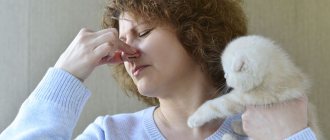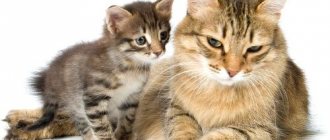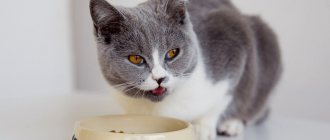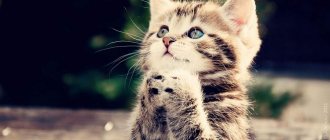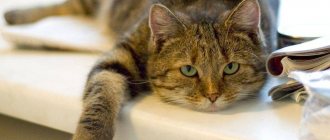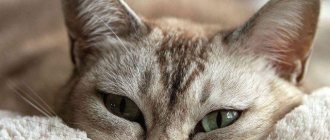Cats are capable of making a wide variety of sounds: from rhythmic purring and gentle meows to prolonged loud howls and snake hisses. The “sound background” depends on the physiological state and emotions, well-being and needs of the pet. Sick cats may cough, sneeze, wheeze, and sniffle. But sometimes the animal makes a sound when breathing, reminiscent of a short snore or grunt. What are the reasons for such a reaction? And is the “grunting state” dangerous to the pet’s health?
Breed predisposition
Among the cat breed, there are artificially bred brachycephalic breeds with a shortened muzzle and a flat profile. A small depressed nose, a high forehead and round eyes look very touching, giving the features a childish defenselessness. They have similar anatomy:
- Persian cat;
- exotic shorthair cat;
- Scottish Fold, or Scottish Fold;
- British Shorthair.
Main problems. Along with the doll's charm, the snub-nosed face creates a lot of health problems, in particular:
- Shortened nasal passages are not able to ensure normal air circulation during breathing. Thus, cold air does not have time to warm up, and hot air, on the contrary, cools down in the anatomical cavities, due to which brachycephalic breeds are very vulnerable to the effects of low and high temperatures. After sitting by a slightly open window in winter, such animals can easily catch a cold, and in summer they suffer from overheating. A comfortable temperature for them is considered to be +18-23°C.
- A defect in the nasal septum and broken airways lead to the fact that short-faced cats constantly wheeze when breathing and snore in their sleep, sucking in air forcefully. It is especially difficult to breathe for the so-called “extreme” people, whose facial part of the skull is excessively shortened. Such animals are often unable to eat and drink water on their own, requiring artificial feeding and watering.
- Blockage of the lacrimal glands leads to constant watery eyes or clear mucous discharge from the eyes, which leads to the appearance of skin irritations and brown-colored “tear tracks.” Such streaks are especially noticeable in white and lightly colored individuals.
- The structure of the soft palate of brachycephalics also creates breathing problems. In many individuals, the overgrown mucous membrane sags in a fold and prevents normal air flow. The problem is exacerbated in older animals with decreased muscle tone and congestion in the tissues. At night, such cats can literally suffocate, emitting annoying wheezing and grunting breathing, frightening the owner. Waking up and trying to regulate their breathing, the poor fellows may experience heart palpitations, bouts of painful coughing and vomiting. In order to alleviate the condition, they are recommended to have an operation to correct the shape of the soft palate, during which the veterinarian removes excess mucous membrane, restoring the physiological norm of the respiratory tract.
Causes of night meowing
If you start to figure out why a cat meows at night for no reason, it becomes clear that she still has a reason to do this. It could be:
Quite often, old cats and cats that are more than 10-15 years old begin to meow at night. It's hard to believe, but it turns out that elderly pets, just like people, can suffer from Alzheimer's disease, which manifests itself in increased restlessness at night. Unfortunately, it is impossible to cure this disease, but you need to try to smooth out its manifestations as much as possible, providing your old and sick pet with maximum attention during the day.
Pharyngeal (pharyngeal) reflex
This condition is also called “paroxysmal breathing” or “reverse sneezing.” It is not a disease, but it looks quite alarming and unusual.
Paroxysmal breathing is recorded not only in cats, but also in dogs and people.
According to felinologists, its cause is irritation of the soft palate, resulting in a kind of spasm. At the same time, the animal rests on its forelimbs, stretches its neck, arches its back and produces sounds reminiscent of a noisy short breath, sneezing, coughing and grunting at the same time.
Causes. The condition can be provoked by:
- emotional state and stress;
- quickly eating or drinking liquids;
- inhalation of cigarette smoke, dust, pollen and other allergens;
- pungent odors;
- respiratory infections;
- squeezing the throat with a harness.
Progression and diagnosis. Usually the cat copes with an attack of reverse sneezing on its own, however, if the respiratory abnormality becomes more and more obvious, then perhaps the animal really is sick. In particular, a gradual increase in symptoms is caused by neoplasms growing in one or another part of the respiratory tract. The owner will be able to independently diagnose them only if the tumors become too large and manifest themselves externally, or enter the decay phase and begin to bleed. Ultrasound diagnostics and x-rays will help dispel all doubts.
Spayed cat or neutered cat
Experience shows that a sterilized cat screams in the apartment at night from lack of attention. In this way, she requires the owner's love, so before you decide to have a pet, weigh the pros and cons again. A cat, even a sterilized one, needs a lot of time. It is not enough to just feed her and sometimes pet her - you need to play with her, communicate with her, pet her, and entertain her. Nature has arranged it in such a way that both animals and humans experience acute melancholy from loneliness and lack of love at night or at dawn.
As for castrated cats, they most often scream in the apartment at night for completely different reasons - they may not only be lonely, but also scared. Your pet can experience anxiety for any reason. In order for him to stop meowing and screaming, it is usually enough to pet him. In addition, cats behave restlessly during weather changes. Their behavior can indicate heavy rain, snowfall, hurricane winds and even an earthquake. Never ignore seemingly unreasonable anxiety in your pets.
Allergic manifestations
Allergies are common among tailed pets. An allergen entering the body during breathing provokes an immune system reaction characterized by irritation and inflammation of epithelial cells, swelling of the mucous membrane of the respiratory tract and accumulation of exudate in the bronchi. As a result, the cat:
- has difficulty breathing through the nose;
- breathes through an open mouth;
- makes wheezing, grunting and coughing sounds.
Allergens:
- dust;
- household chemicals;
- chemical preparations for ectoparasites;
- tobacco smoke;
- aerosols and any flavored perfumes;
- cat litter;
- paint and varnish products;
- flower pollen.
Associated symptoms. Difficulty breathing due to allergies is accompanied by:
- sneezing and watery discharge from the nasal passages;
- redness of the eyes and watery eyes;
- itching and the need to constantly rub the face with your paws;
- redness in the throat, dry cough and difficulty swallowing;
- skin and coat problems.
Nature of manifestations. The severity of respiratory allergic manifestations can vary and may include:
- allergic laryngitis and tracheitis;
- allergic bronchitis;
- bronchial AS src=»https://porodakoshki.ru/wp-content/uploads/2019/10/Virusnye-zabolevaniya-dyhatelnyh-putej-e1571507833171.jpg» class=»aligncenter» width=»600″ height=»338″ [/img]
In the latter case, the animal suffers from episodic attacks of suffocation caused by bronchospasm, swelling of the respiratory tract mucosa and excessive mucus production by the bronchial epithelium. At such a moment, it seems that the animal cannot take a breath, breathing with wheezing and whistling.
Asthma most often affects adult cats aged 2 years and older.
Methods of therapy. To relieve allergy symptoms, the veterinarian prescribes antihistamines and corticosteroids, and for asthma, special aerosols. An allergic cat must be kept at a comfortable temperature with humidification, preventing the inhalation of dust, tobacco smoke and other substances hazardous to it.
Treatment
The method of treating an animal should only be prescribed by a veterinarian after a diagnostic examination. Based on its results, various therapeutic measures can be prescribed, for example:
Self-medication is strictly prohibited. Such a reckless act can lead to a deterioration in the animal’s well-being and even suffocation.
Helminthiasis
An animal carrying parasitic worms can make unusual grunting sounds.
Toxocara. The development cycle of the Toxocara nematode begins with the cat swallowing food infested with larvae or eating the intermediate host of the parasite, which is:
- mouse;
- rat;
- bird;
- insect.
Development in the body . In the intestine, the larva actively invades the blood vessel through the epithelial wall in order to enter the lungs with the bloodstream. Young parasites feed on the blood and tissues of the airways, causing severe irritation, difficult wheezing breathing and a reflex cough.
The damaging effect leads to the attachment of pathogenic bacteria that increase inflammation. With a cough, some of the larvae enter the oral cavity and are swallowed again, growing in the intestines into a mature worm. During the period of migration of larvae into the digestive tract, the cat may experience the urge to vomit.
Hookworm. Hookworm larvae cause hookworm disease by entering the cat’s body in several ways:
- simultaneously with food and water;
- when self-licking;
- through the skin with subsequent penetration into the bloodstream;
- when eating infected rodents.
Development. The path of larvae that have penetrated through the skin into the blood lies in the respiratory tract, and then, when coughing, into the oral cavity.
After 3 weeks, swallowed parasite embryos grow in the intestines into adult individuals that feed on the blood of the host animal.
Clinical picture of helminthic infestation. Infection with helminths in a cat is indicated by:
- poor appetite and weight loss;
- apathetic behavior;
- disruptions in the gastrointestinal tract;
- increase in abdominal volume;
- the appearance of mucus and blood in feces;
- unkempt appearance, poor coat;
- constant discharge from the eyes;
- pallor of the mucous membranes in the mouth.
Diagnosis and treatment. The diagnosis is based on laboratory tests of blood and feces. Having determined the type of helminth, anthelmintic drugs are prescribed in the required dose and, possibly, with repeated use.
Also watch the video of a cat breathing with wheezing:
What to do and how to calm an animal meowing at night?
Above, we figured out why a cat yells for no reason at night, and now let’s talk about how to calm an agitated animal. Experienced breeders recommend:
If, despite the measures taken, the cat still continues to scream at night, then it’s time to show him to the veterinarian. A professional examination will let you know if your pet needs treatment or if it needs to be wormed to stop the nightly concerts.
Comprehensive diagnostics
Cat owners should remember that any pathology has several manifestations at once, which make it possible to more accurately determine the disease. If you don't notice any changes in your pet other than snoring, there is most likely no cause for concern. Of course, an extra trip to the vet is never harmful.
If you have any doubts about your cat's health, take it to the veterinarian, describing in detail your pet's snoring.
However, cats whose snoring is accompanied by other negative symptoms that are not immediately noticeable and sometimes almost completely unnoticeable deserve special attention. Less obvious manifestations of a possible disease include:
When diagnosing the disease, you should pay attention to the painful manifestations that accompany snoring.
Taking an anamnesis
If you have checked one or more items from the above list, you should collect a preliminary medical history to prepare for the veterinarian’s upcoming questions. The anamnesis includes the following information:
A comprehensive history will help the veterinarian quickly understand the pet’s condition.
Why do kittens twitch in their sleep?
Answer to the first question
: Not only kittens twitch in their sleep, but all animals, including humans. The brain is to blame again! Physical activity forces the muscles to remain in constant tone, and when falling asleep, the brain sends a short-term impulse: “Relax urgently!” - and the muscle twitches so that we can begin sleepy relaxation. The same thing happens in kittens: an impulse - the kitten twitched, as if from an electric shock. But this is an absolutely painless phenomenon! Scientifically, it is myoclonus.
Answer to the second question:
Cats' front teeth are shorter than their canines. When the jaws close during sleep, a rather impressive gap remains between the incisors, where the “lost control” tongue ends up. Well, it fell out and fell out - there’s nothing wrong with that!
Causes of snoring in brachycephalic cats
Since this phenomenon is well-known, veterinarians have already accumulated statistics on the most common pathologies.
Nostril stenosis in brachycephalic cats
In Russian-language veterinary literature, this phenomenon is almost not considered, but practicing specialists are confident that its importance is clearly underestimated. In this case, stenosis implies thickening of the tissues lining the inside of the nasal cavity.
The causes of stenosis vary, with many experts suggesting that brachycephalics have a genetic predisposition. Chronic inflammatory diseases of the respiratory system, the effects of irritating and toxic substances, allergies, etc. play a major role.
In severe cases, stenosis leads not only to relatively harmless snoring, but also to serious respiratory failure. This, in turn, is fraught with deterioration in oxygenation of tissues throughout the body, which will inevitably lead to the development of other pathologies.
Lengthening the soft palate
Another pathology characteristic of cats with a flattened muzzle. The supposed reason for the development is the genetic predisposition of the breeds described above. As the name suggests, in this case the tissues of the soft palate lengthen and sag, blocking the respiratory lumen.
During wakefulness, when tissue tone is relatively high, no symptoms may appear. But during sleep, when the pet’s body is completely relaxed, the soft palate sags greatly and “falls” into the lumen of the respiratory organs. This causes snoring and severe breathing problems. Sick cats sleep poorly, wake up abruptly, and this process is accompanied by wheezing, loud meowing and other “special effects.”
Internal laryngocele
A pathology characteristic only of Persian and Himalayan cats. It is extremely rare in representatives of other breeds. With this disease, swelling and growth of false vocal folds are noted.
One of the characteristic signs is the same snoring. Also, sick cats are distinguished by a strange hoarse meow, and during “conversations” the pets often cough and wheeze. In extremely rare cases, laryngoceles can grow through the soft tissues of the neck (i.e., external laryngoceles appear). In this case, they are easily distinguishable as swelling under the skin.
Treatment at the veterinary clinic
If you are unlucky enough to encounter a similar problem, be prepared for a full examination of your pet. The veterinarian analyzes the condition of the throat and nasopharynx and, if necessary, prescribes x-rays and blood tests. Some examinations involve putting the cat into medicated sleep.
When the cause of the disease becomes clear, treatment is prescribed. For each individual case there are different prescriptions: pills, injections, ear swabs, droppers, various kinds of diets and even operations. It all depends on the severity of the case.
For example, in case of obesity, it is enough to switch the cat to specialized food. With hyperplasia of the soft palate, the owner should put up with snoring. Surgery is performed only in cases where there is an immediate risk to the health or life of the cat. Parasitic infestation is treated by taking special tablets.
ATTENTION! To prevent parasites from appearing in your cat’s body, give him preventive tablets. Cats with asthma are given steroids based on how advanced the disease is.
Cats with asthma are given steroids based on how advanced the disease is.
A healthy animal is the key to family peace. Remember that physiological snoring cannot be cured. But if you see something big in him, don't delay going to the veterinary clinic.
About cat snoring
You should treat snoring normally if you have a representative of any brachycephalic breed - such animals have a short and often flattened nose. For example, many Persians sleep quite loudly from childhood.
Cats, like people, also sometimes dream. They are usually very rich and bright. In his dreams the pet:
At such moments the beast strongly:
This is usually accompanied by clenching the fingers, extending the claws, wagging the tail, etc. It is not difficult to stop this - just change the cat’s position. As a rule, such situations do not occur too often and do not pose a health hazard. The only thing that can make you worry is frequent dreams. They often indicate that your pet is stressed.
However, you need to be wary when your pet, in the previous years of its life, rested quietly, then suddenly begins to make characteristic sounds during sleep.
Eating and snoring. Is there anything in common between them?
Diet is directly linked to snoring
Obesity is one of the causes of snoring, so this point needs special attention. If the cat is overweight, it is very difficult for him to breathe, so he begins to snore
If you have learned that nutrition is the main method of treating snoring, then consider a few points.
It is important not to put your pet on a strict diet, as this can harm its health. Reduce food portions gradually so that the cat’s body is not in shock
Let's give our cat healthy and varied food. After a while, the cat will acquire a normal shape and the snoring will disappear on its own.
I have been a veterinarian for a long time, unfortunately, many do not understand that snoring is a serious problem in cats that leads to complications. If you start treating the cause of snoring in time, then your pet will not experience the side effects of snoring. A common cause of sniffling is excess weight, so, dear owners, do not overfeed your cat, but make sure that he eats healthy food in a balanced amount.
Many owners do not know that cats have no sense of proportion and if you give them a lot of food, they will immediately eat it. Give your pet small portions of food to prevent him from gaining excess weight. Do not forget that nutrition greatly affects the health of animals, so you should not feed your pet just anything.
The first thing to do when your cat sniffles is to see a specialist. Timely treatment will protect your pet from bad consequences. Do not treat your cat without knowing the cause of its snoring.
If your cat is overweight, then get her to exercise. Awaken her hunting instinct so that she moves a lot. Buy her toys or let her out into the fresh air to hunt.
Sometimes surgery may be necessary to remove foreign bodies that are preventing your cat from breathing normally. If this is not done on time, then due to a lack of oxygen, malfunctions will begin to occur in the cat’s body.
It is impossible to say unequivocally how to treat snoring in cats, since this is due to the individual characteristics of the pet, the causes of snoring and many other factors.
Why does a cat snore in its sleep and what does it mean?
When a cat snores loudly, many stress-resistant owners do not pay attention to it; people with light sleepers simply send their pet to sleep in another room. But, as a rule, no one thinks about the fact that an animal’s “loud” sleep may indicate illness.
About cat snoring
You should treat snoring normally if you have a representative of any brachycephalic breed - such animals have a short and often flattened nose. For example, many Persians sleep quite loudly from childhood.
Cats, like people, also sometimes dream. They are usually very rich and bright. In his dreams the pet:
At such moments the beast strongly:

